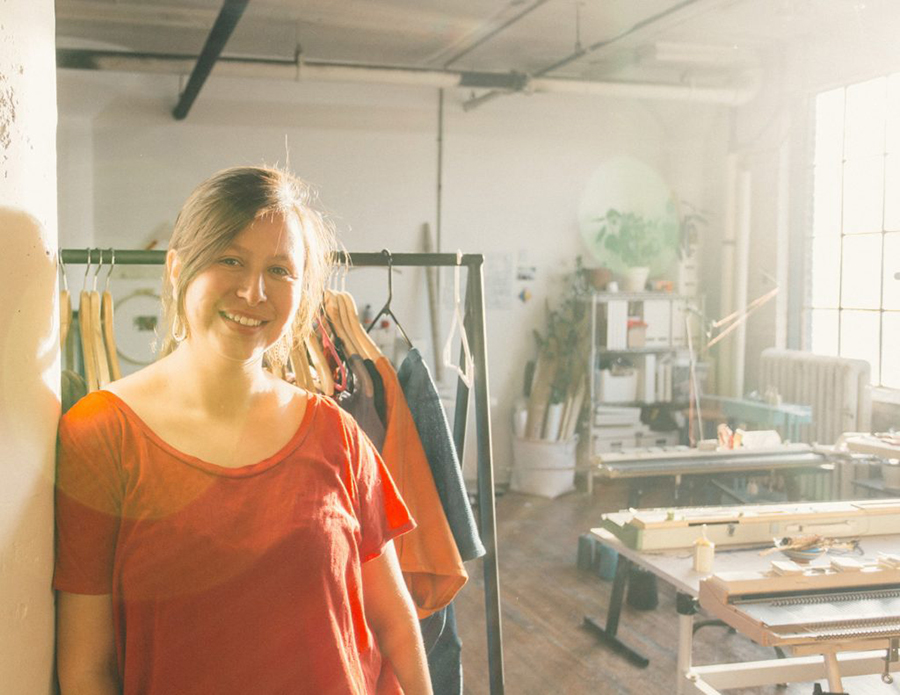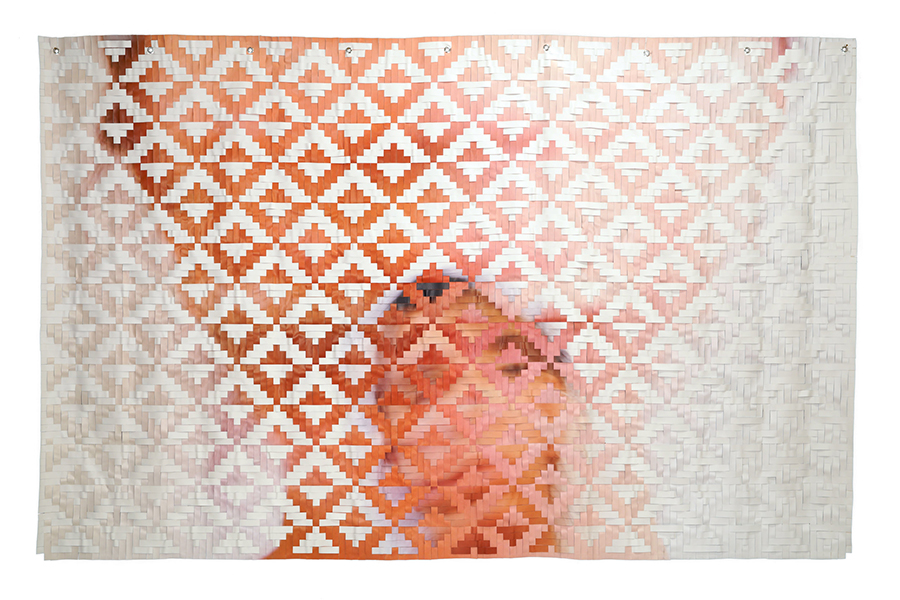
In the Studio with Maggie Thompson
Published June 18th, 2018 by Juleana Enright
One of NEMAA’s many talented artist members, Maggie Thompson brings her life to her loom in the Northrup King Building.

With a passion for weaving political and cultural elements into high quality wearable goods, Ojibwe textile artist Maggie Thompson proves that craft and art go hand in hand. The founder of Makwa Studio based in the Northrup King Building, Thompson hand weaves each of her signature designs — caps, cowls, tunics, and tops — using luxury, American-sourced yarn. She also creates fine art tapestries and sculptural installations that don’t pull any punches. She incorporates an emotional dialogue into her work through subtle references to her Native culture (“Makwa” means “bear” in the Ojibwe language) and addresses contemporary Native issues such as appropriation, stereotyping, blood quantum, and the intimacy of community through weaving, screen printing, and knitting.
 Photo by Bobby Rogers for NEMAA.
Photo by Bobby Rogers for NEMAA.
We caught up with Maggie to get a look into her process and learn more about her studio life.
Juleana Enright: Your technical process looks pretty slick and portable. What is your favorite part of your process, and how would you describe how you use it to create work?
Maggie Thompson: My favorite part of knitting and weaving is playing with all the different colorways that you can incorporate into one pattern. I usually start with a drawing and then map it out to be used as a punch card pattern for my knitting machine. Then I will usually create a small fabric sample testing out different colorways.
 Photo by Bobby Rogers for NEMAA.
Photo by Bobby Rogers for NEMAA.
JE: What’s the hardest thing about your knitting and weaving practice?
MT: I think the hardest thing is just always having to pay really close attention to the details, and is mostly a lot of drafting and counting — to gauge size, change colors, or keep a consistent design repeat. The yarn can also slip off the needles fairly easily which can result in your whole piece falling off the machine. It takes a lot more brain power than you'd think. It's also very physical work so I can only do so much at a time.
JE: How do you utilize your studio space? Why is having a studio in Northeast and being part of that art community important to you?
MT: My studio space is full of equipment — looms, knitting machines, sewing machines, and lots and lots of yarn. I do most of my thought process at home but do all the execution in studio.
I love having a space because of the community and history of the arts in that area. My mom has had a space at NKB since I was in 4th grade, so it's pretty much like a second home to me. The space is also affordable compared to a lot of other spaces and is accessible 24/7 with elevators which is key for moving things when you're doing a bunch of shows.
JE: What’s the most indispensable item in your studio?
MT: Aside from my knitting machine, it'd probably be my latch hook or transfer needle, both of which I use for my knitwear projects.
 In Loss; vinyl, photography, weaving; 9 x 11’, 2015
In Loss; vinyl, photography, weaving; 9 x 11’, 2015
JE: What question are you asking in your work right now?
MT: The majority of my inspiration comes from my Native Ojibwe heritage and family history, especially for my knitwear. For my fine art work I also explore themes of grief and anxiety and how art can be used as a tool for healing.
I actually haven't been making a lot of new work right now but am just starting to expand old concepts on grief and loss, but this time while reflecting on the ending of a romantic relationship. In addition, exploring ideas of self worth, stability, and the understanding of love within a romantic context.
JE: What risks do you want to take in your work and how has working within this challenge changed you?
MT: I want to start doing more installation work with textiles and more sculptural knitwear fashion pieces. I also like to use different materials from each fine art piece to the other. In this sense I am constantly challenged because of learning how different materials behave with another. So far my knitwear has been flat pattern pieces but making them more sculptural will also force me to think about how the piece will react and conform to the body.
JE: What kind of creative patterns, routines, or rituals do you have?
MT: When I'm working I always need to be listening to music and have a coffee at hand. Then when I need a break I usually go on a bike ride or do pole fitness.
 For Love Alone; vinyl, metallic thread, & beads sewn into a body bag; 3.5 x 7.5’; 2016.
For Love Alone; vinyl, metallic thread, & beads sewn into a body bag; 3.5 x 7.5’; 2016.
JE: How do you know when a piece is finished?
MT: My work usually revolves around a lot of math and set sequences so all I have to do is decide on how big I want my piece to be and then plug everything else in.
JE: When did you first realize that creating was something you wanted to do? Describe that moment?
MT: I have been creating ever since I was a little kid. One of my earliest memories was with my mom and drawing in my journal. She told me to scribble on a page and then look for a familiar image out of my scribble and bold the lines to make the image come out clearer. She also taught me how to do blind contour drawings as kid as well.
JE: Could you describe your work in five words?
MT: Colorful, Bold, Emotional, Warm, Repetitive
 Fragments; foamcore, fabric, photography, & assemblage; 8x 10’; 2016.
Fragments; foamcore, fabric, photography, & assemblage; 8x 10’; 2016.
For more on Maggie Thompson’s artwork and knitwear, visit MakwaStudio.com. For more on the Northeast Minneapolis Arts Association, visit NEMAA.org.
This article originally appearing in the Spring 2018 issue of N Studio, NEMAA's biannual magazine.
We can't do it without you.
Help keep independent arts journalism alive in the Twin Cities.